Why Your Lighting Plan is so Important to Your Remodel
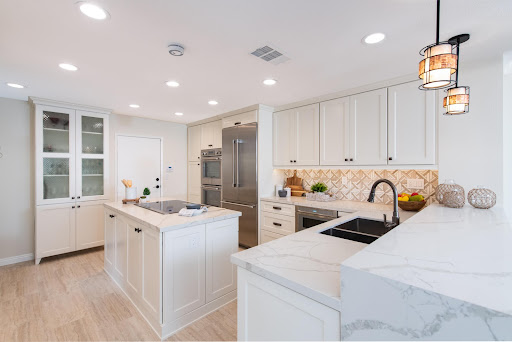
We often take lighting for granted. Trust us when your lighting plan is wrong, you’ll know exactly why you need a lighting plan. Have you ever moved into a new home and found that you continue to reach for the wrong wall to flip the switch on when you walk in?
Another example of lighting functionality that you will want to be sure you get right for your remodel. Or even worse, you view your new home during the day and move in to find out there is no ambient lighting in any room except your bathroom and walk-in closets.
Now consider the increase in labor and materials as a result of the pandemic and your new home may cost you an additional $5,000 to get your lighting plan and installation in place. Also, consider the additional options that make life nicer like dimmer switches and 3-way switches. From design to function, you’ll find that lighting plays a bigger role in your home than you may have considered.
Let us help you with your whole home remodels with our professional home remodeling services.
Keeping Your Remodel Looking Professional
Understanding the purpose of lighting is important and why you want to involve a residential designer in creating your lighting plan. While lighting may seem obvious and simple, the different functions in lighting are used differently in placement.
General Lighting: This is the lighting you are used to using for illuminating each space. These are often can lighting or recessed lighting.
Task Lighting: This is precisely as it sounds, used for illuminating space for tasks. You will need more light when crafting or reading than when you watch TV.
Accent Lighting: These lights highlight features in your home. You will find these lights over art pieces, architectural features, fountains, under cabinets, toe kicks, and more.
Now knowing the different types of lighting is illuminating, it may not make designing your lighting plan any easier as when you shop, you may not know which type of light the fixtures you select are delivering. Your designer would never use accent lighting in a place that necessitated general lighting and you may need this knowledge to keep your remodel looking professional in design and function.
Related: Home Remodeling Resources
Your Lighting Plan is One of the Most Important Aspects of a Remodel
Lighting not only affects the overall look of your remodel, it also sets the stage for ambiance, mood, and design. A well-designed lighting plan can significantly contribute to your overall home aesthetic and experience.
Each space has a purpose and you want to set the stage for that room to ensure you are delivering the proper ambiance. This also includes the position of each lighting fixture and type; from the spacing between can lighting to how tall a lamp should be or at what level you place a lamp.
These simple elements can drastically change the feel of your space. Be sure to get it right by working with your designer.
Set the Mood with Lighting
If there is one thing we know well, it’s that lighting affects mood. We tend to be happier in longer daylight than in winter with less daylight; it’s this same phenomenon in the lighting in your home. You may have noticed that homes with dark spaces set the mood and tone and leave you feeling a bit gloomy. Lighting also sets the stage for what you expect in that space.
You want to be sure all spaces have adequate lighting all year long regardless of the ample natural light that may shine in during certain seasons – after all, it’s night once a day. Consider a room that has too bright of lights can also feel like you’re in a grocery store and makes the room feel like you’re unable to relax. A perfectly lit room is an immediate mood boost.
Lighting as Decoration
In addition to function, design is the fun part of this. Lighting has so much flexibility to be fun that it also impacts mood. A fancy chandelier may be your style but not right for the type of light you need; there’s a simple solution here, add a dimmer switch and you can have a fancy chandelier in your master bathroom – these are very popular as of late.
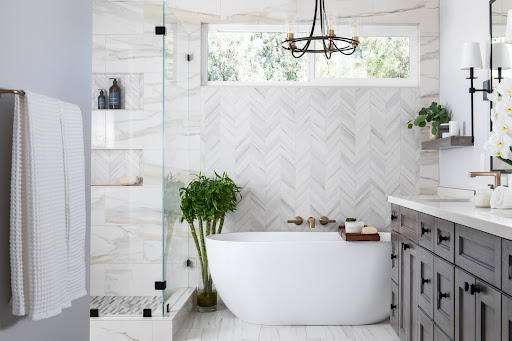
Pendant lights are really fun – they are considered accent lighting, so you will still need general lighting while you show off your design style. You can see below that fun pendants were used but also recessed lighting to ensure there is enough light that you feel good walking and cooking in the space.
You also want to consider your counter height of where you are placing pendants; bar height counters are not a great place for long pendants but there is still accent lighting you can use at a bar that is fun and trendy. Pendants are also an affordable design option to switch out as trends change.
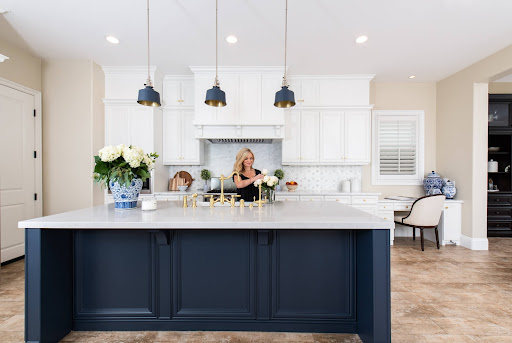
Below you will see some Pottery Barn pendants that got picked up by Pottery Barn themselves and shared on Instagram. This farmhouse design style used both the pendant lights and under-shelf lighting as well as under hood lighting which serves as task lighting for cooking.
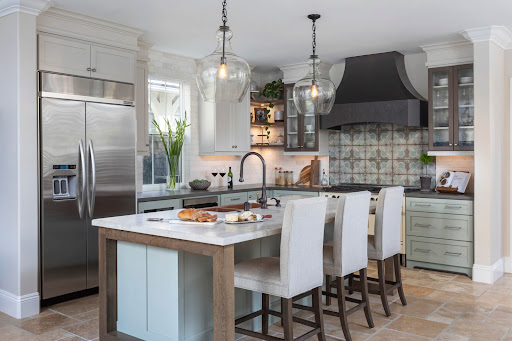
What Goes Into a Lighting Plan
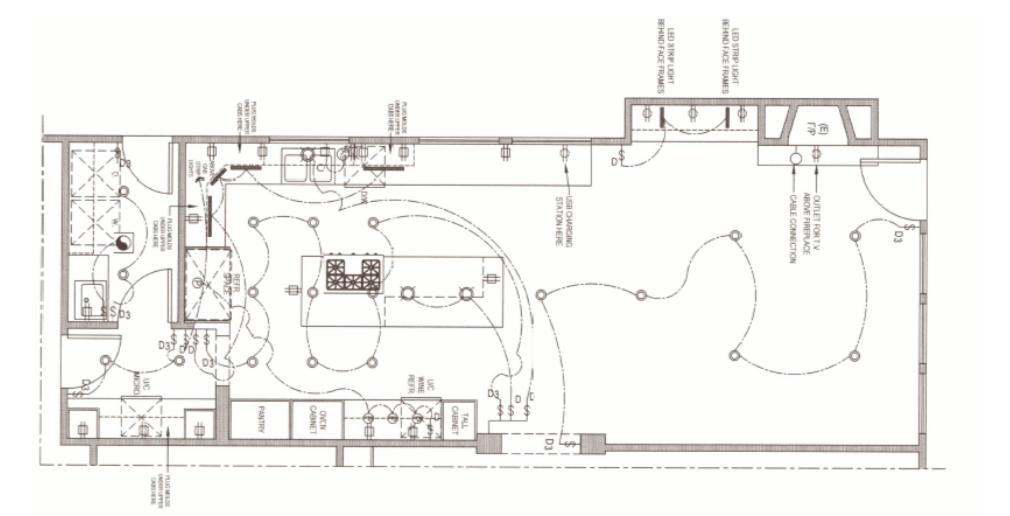
While we have been referencing lighting plans, we have not shared exactly how technical this can be – another reason you want to consult a professional designer, as your electrician does not consider design when given free rein to install your lights. If left up to your electrician, you may end up with 20 can lights, no dimmers, no design, and possibly non-symmetrical installation. We often start the lighting plan before considering any other remodel elements. These are the steps to creating a successful lighting plan.
- Take your as-built plans (if available) or sketch your floor plan in absence of the as-built floor plans. This gives you an areal view of your space so you can design your lighting accordingly.
- Identify where your general light needs to come from and where your task lighting needs to be. You can detail the accent lighting after determining the features you want, but it still needs to be done early on as electrical installation comes before any cabinetry or finishings. This means while you have selected your pendant lighting, the electrical panel needs to support all lighting and be installed before any of the real lightings is installed.
- One of the crucial steps to your lighting plan is determining where your switches and sockets will go. This is all about design functionality. Are you right-handed or left-handed, what wall is natural to reach, and where will it not be an eyesore. There are also legal requirements as to how many sockets you need per linear foot. Working with professionals eliminates multiple plan checks in the city.
- Next step is to define your budget of how much you want to spend on the framework of lighting versus the actual light fixture itself. Lighting your kitchen may take up to $9,000; if you want to reduce the budget, you may need to select lower-priced finishes.
- Select light fixtures – the fun begins here! Now that you have set your budget and decided which lights go where, you get to go shopping!
Room by Room Lighting Plans
When you are remodeling multiple spaces, you will want to do a room-by-room lighting plan with these guided tips for selecting the type of lighting you want for the activities that will be done in the space.
Here are some basic guidelines to you know which rooms require what type of lighting.
Kitchen Lighting
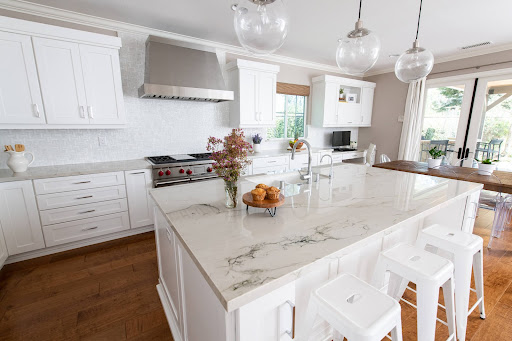
Your kitchen is much more than your cooking space – as they say, your kitchen is the heart of your home. Not only do you prepare delicious meals here, ensure cabinets are stocked and dishes are clean, you use this space as a multi-purpose room. Your friends and family gather here to socialize, enjoy munchies, and sometimes it’s your make-shift office, kids’ homework space, or crafting area. And if you’re a foodie, it may be your stage for Instagram. All of these activities require general lighting and some of these require task lighting.
Be sure to have task lighting over your sink and over your stove. You may use LED lights under cabinets for an elegant vibe.
Related: 2018 Kitchen Trends: Lighting Guide
Living Room Lighting
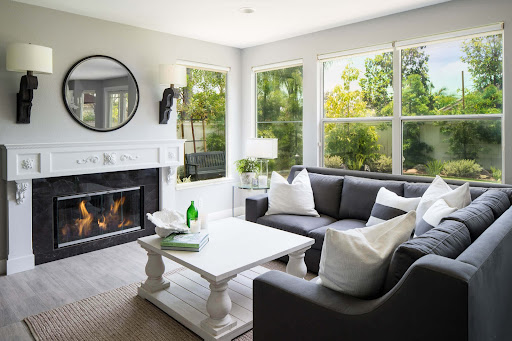
You want a welcoming and inviting mood in your living room. Set your living room lighting backdrop with your general lights on a dimmer so you can control the amount of light you want for different times of the day or evening pending the amount of natural light.
If you have a bar, under-shelving lighting makes this space feel elevated and draws attention to the beautiful bar. Pending your design style, you may consider a chandelier in your living room, also on a dimmer light. You will want accent lighting over your fireplace and over any artwork or notable architectural detail.
Bedroom Lighting
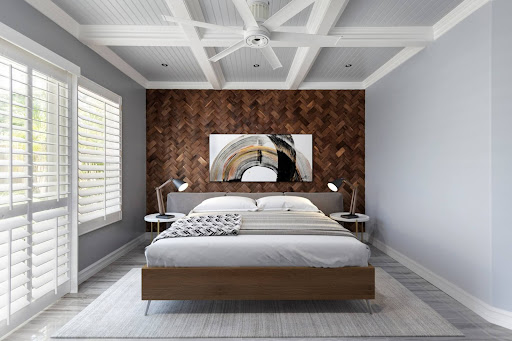
This room is fairly simple to light. You want bright light in the morning where you may use shades to filter the amount of natural light that pours in during the morning hours and serene light during the bedtime hours.
To accomplish this, you will want soft background lighting with bedside task lighting. You may consider toe kick lighting under your bathroom vanity that you may use as a night light.
Hall Bathroom Lighting
You can keep it simple here. If you are lucky you have some natural lighting that comes in over a window above your shower – you want lighting over your mirror if it’s a small bathroom so your guests may use the mirror to refresh themselves. If it’s a tad larger you will want both above the mirror and general lighting so it’s ample enough to not feel dimply lit. We definitely don’t want that dark feeling for ourselves or our guests.
Master Bathroom Lighting
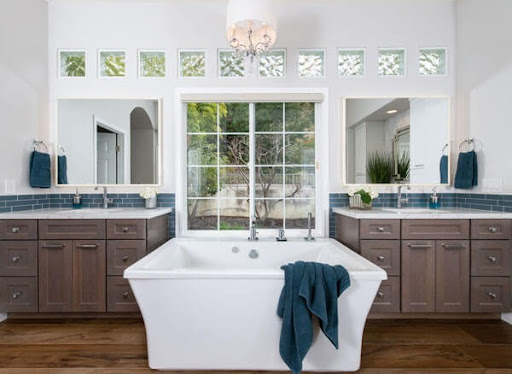
They say the bathroom is the place we go to seek refuge and it’s considered our private hideaway where you can expect privacy; it’s this reason people are starting to design extravagant master baths with all the trimmings of a spa oasis.
They want a retreat where they can feel pampered and relaxed for rejuvenation of what’s to come. Here is where you want your general light on a dimmer so you can relax in your spa tub as well as chandelier for the fancier of us, and task lighting over your mirrors and make-up station to get the details right from shaving to beautifying.
You may also want brighter lights in your shower for the purpose of shaving as well. You also may consider LED strip lighting under your vanity that may also be used as a night light. And if you have not seen the backlit mirrors, you may want to consider one – they are fantastic with built-in dimmers.
Related: Lighting Upgrades to Consider for Your Home Remodel
Final Words on Lighting Plans
We hope we have instilled in you how important lighting plans are to your overall remodel design. From function to design and room, you need to take into consideration a lot of items. Your contractor will take care of the electrical panel and tell you how many circuits you need for the number of lights you have drawn in your plan – this may also have you considering how much you want to light with different amp lights.
When remodeling your home, consider redoing other rooms like your kitchen or bathroom. If you’re having trouble getting started, Sea Pointe Design & Remodel can help.